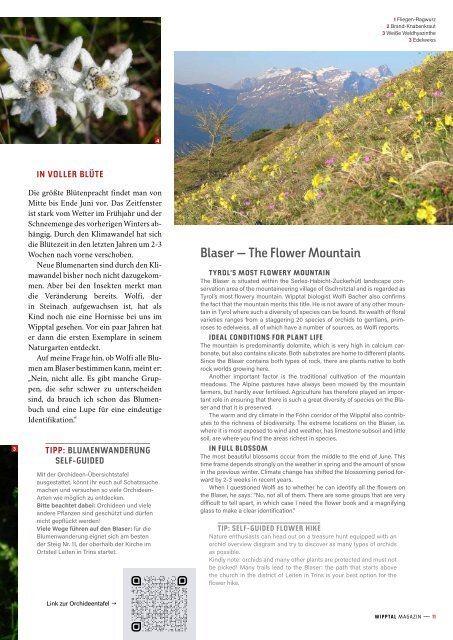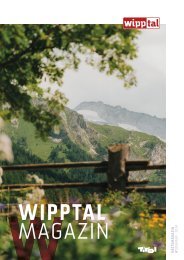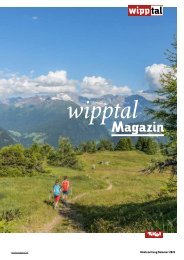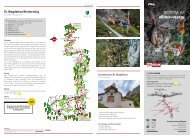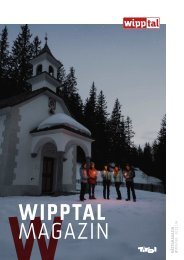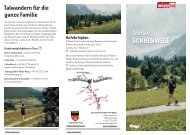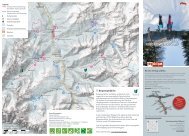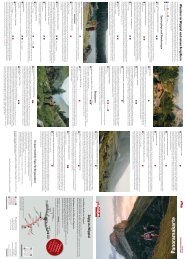Wipptal Magazin Sommer 2023
Geschichten und Tipps aus dem Wipptal inklusive Wipptal Guide, Gästeprogramm und Veranstaltungen
Geschichten und Tipps aus dem Wipptal inklusive Wipptal Guide, Gästeprogramm und Veranstaltungen
- Keine Tags gefunden...
Sie wollen auch ein ePaper? Erhöhen Sie die Reichweite Ihrer Titel.
YUMPU macht aus Druck-PDFs automatisch weboptimierte ePaper, die Google liebt.
1 Fliegen-Ragwurz<br />
2 Brand-Knabenkraut<br />
3 Weiße Waldhyazinthe<br />
3 Edelweiss<br />
4<br />
3<br />
IN VOLLER BLÜTE<br />
Die größte Blütenpracht findet man von<br />
Mitte bis Ende Juni vor. Das Zeitfenster<br />
ist stark vom Wetter im Frühjahr und der<br />
Schneemenge des vorherigen Winters abhängig.<br />
Durch den Klimawandel hat sich<br />
die Blütezeit in den letzten Jahren um 2-3<br />
Wochen nach vorne verschoben.<br />
Neue Blumenarten sind durch den Klimawandel<br />
bisher noch nicht dazugekommen.<br />
Aber bei den Insekten merkt man<br />
die Veränderung bereits. Wolfi, der<br />
in Steinach aufgewachsen ist, hat als<br />
Kind noch nie eine Hornisse bei uns im<br />
<strong>Wipptal</strong> gesehen. Vor ein paar Jahren hat<br />
er dann die ersten Exemplare in seinem<br />
Naturgarten entdeckt.<br />
Auf meine Frage hin, ob Wolfi alle Blumen<br />
am Blaser bestimmen kann, meint er:<br />
„Nein, nicht alle. Es gibt manche Gruppen,<br />
die sehr schwer zu unterscheiden<br />
sind, da brauch ich schon das Blumenbuch<br />
und eine Lupe für eine eindeutige<br />
Identifikation.“<br />
TIPP: BLUMENWANDERUNG<br />
SELF-GUIDED<br />
Mit der Orchideen-Übersichtstafel<br />
ausgestattet, könnt ihr euch auf Schatzsuche<br />
machen und versuchen so viele Orchideen-<br />
Arten wie möglich zu entdecken.<br />
Bitte beachtet dabei: Orchideen und viele<br />
andere Pflanzen sind geschützt und dürfen<br />
nicht gepflückt werden!<br />
Viele Wege führen auf den Blaser: für die<br />
Blumenwanderung eignet sich am besten<br />
der Steig Nr. 11, der oberhalb der Kirche im<br />
Ortsteil Leiten in Trins startet.<br />
Blaser – The Flower Mountain<br />
TYROL’S MOST FLOWERY MOUNTAIN<br />
The Blaser is situated within the Serles-Habicht-Zuckerhütl landscape conservation<br />
area of the mountaineering village of Gschnitztal and is regarded as<br />
Tyrol’s most flowery mountain. <strong>Wipptal</strong> biologist Wolfi Bacher also confirms<br />
the fact that the mountain merits this title. He is not aware of any other mountain<br />
in Tyrol where such a diversity of species can be found. Its wealth of floral<br />
varieties ranges from a staggering 20 species of orchids to gentians, primroses<br />
to edelweiss, all of which have a number of sources, as Wolfi reports.<br />
IDEAL CONDITIONS FOR PLANT LIFE<br />
The mountain is predominantly dolomite, which is very high in calcium carbonate,<br />
but also contains silicate. Both substrates are home to different plants.<br />
Since the Blaser contains both types of rock, there are plants native to both<br />
rock worlds growing here.<br />
Another important factor is the traditional cultivation of the mountain<br />
meadows. The Alpine pastures have always been mowed by the mountain<br />
farmers, but hardly ever fertilised. Agriculture has therefore played an important<br />
role in ensuring that there is such a great diversity of species on the Blaser<br />
and that it is preserved.<br />
The warm and dry climate in the Föhn corridor of the <strong>Wipptal</strong> also contributes<br />
to the richness of biodiversity. The extreme locations on the Blaser, i.e.<br />
where it is most exposed to wind and weather, has limestone subsoil and little<br />
soil, are where you find the areas richest in species.<br />
IN FULL BLOSSOM<br />
The most beautiful blossoms occur from the middle to the end of June. This<br />
time frame depends strongly on the weather in spring and the amount of snow<br />
in the previous winter. Climate change has shifted the blossoming period forward<br />
by 2-3 weeks in recent years.<br />
When I questioned Wolfi as to whether he can identify all the flowers on<br />
the Blaser, he says: “No, not all of them. There are some groups that are very<br />
difficult to tell apart, in which case I need the flower book and a magnifying<br />
glass to make a clear identification.”<br />
TIP: SELF-GUIDED FLOWER HIKE<br />
Nature enthusiasts can head out on a treasure hunt equipped with an<br />
orchid overview diagram and try to discover as many types of orchids<br />
as possible.<br />
Kindly note: orchids and many other plants are protected and must not<br />
be picked! Many trails lead to the Blaser: the path that starts above<br />
the church in the district of Leiten in Trins is your best option for the<br />
flower hike.<br />
Link zur Orchideentafel →<br />
WIPPTAL MAGAZIN —— 11


